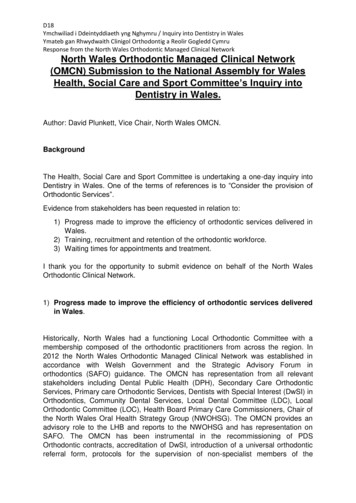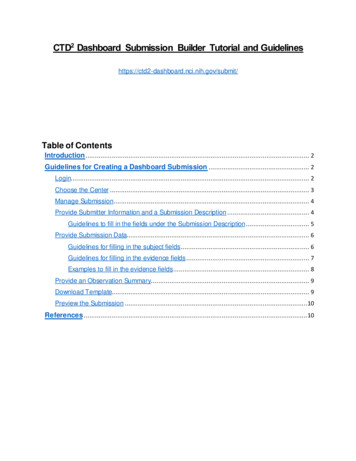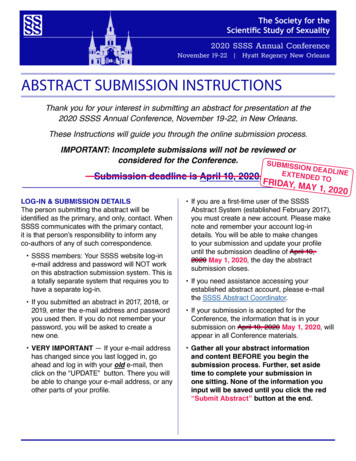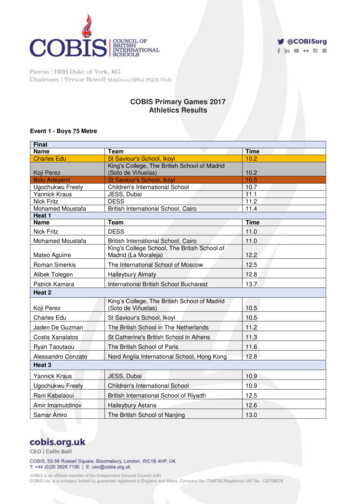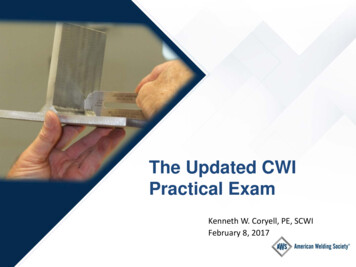
Transcription
D15Ymchwiliad i Ddeintyddiaeth yng Nghymru / Inquiry into Dentistry in WalesYmateb gan Gymdeithas Orthodontig PrydainResponse from the British Orthodontic SocietyBritish Orthodontic Society (BOS) Submission to the NationalAssembly for Wales Health, Social Care and Sport Committee’sInquiry into Dentistry in Wales.Author: Mr. Benjamin R.K. Lewis, Consultant Orthodontist.BackgroundThe British Orthodontic Society (BOS) is a charity that aims to promote the study andpractice of orthodontics, maintain and improve professional standards in orthodontics, andencourage research and education in orthodontics.The BOS is also a representative body of all branches of general dentists and specialistorthodontists in the UK who provide orthodontic care. The Groups within the Society arethe Orthodontic Specialists Group, Practitioner Group, Community Group, ConsultantOrthodontist Group, University Teachers Group and the Training Grades Group.Orthodontics is the dental specialty concerned with facial growth; the development of thedentition and occlusion; and the assessment, diagnosis and treatment of malocclusions andfacial irregularities.Orthodontic treatment provided by the National Health Service (NHS) is undertakenaccording to clinical need as determined by the Index of Orthodontic Treatment Need(IOTN).Orthodontic treatment is recognised to have a range of health benefits including thereducing the risk of dental trauma from prominent teeth; reducing the risk of rootresorption of adjacent teeth from impacted teeth; recreation of space for the replacementof missing teeth or eliminating the space completely to reduce the restorative burden in thefuture; improving the ability to clean the teeth and reducing the risk of dental caries;improving dental function; and correcting dento-facial deformity .One must consider the definition of health in its entirety as promoted by the World HealthOrganisation: “Health is a complete state of physical, mental and social well-being and notmerely the absence of disease or infirmity.”With this in mind, in addition to the dental health benefits highlighted above, there is alsoan improvement in the appearance, self-esteem and psychological well being, which can beespecially important during the formative years of adolescence.Orthodontic provision in Wales is undertaken by a range of professionals: OrthodonticTherapists (under supervision), Dentists with Enhanced Skills (DES)/Dentists with SpecialInterest (DwSI) in Orthodontics; and Orthodontic Specialists; in a range of clinicalenvironments: General Dental Practice; Specialist Orthodontic Practice; Community Dental
Clinics; District General Hospitals; and Cardiff University Dental Hospital. Who undertakes anindividual’s orthodontic treatment is determined by the complexity of the malocclusion andthe treatment required; any additional dental, medical and social needs of the individual;and the availability of the required expertise within the geographical area.To date there have been three major documents produced with regards to orthodonticprovision by the National Assembly for Wales:-National Assembly for Wales Health, Wellbeing and Local Government Committee –Orthodontic Services in Wales, February 2011National Assembly for Wales Health and Social Care Committee – OrthodonticServices in Wales, July 2014“Review of the Orthodontic Services in Wales 2008-09 to 2015-16.” (ProfessorRichmond 14/12/16). This document supersedes the Professor Richmond’s previous“Review of the Orthodontic Services in Wales 2013-14.” (Professor Richmond06/02/15)With regards to the current Inquiry, the BOS have been asked to comment of the followingareas:1) Progress made to improve the efficiency of orthodontic services delivered in Wales,with reference to the recommendations of the previous reports.2) Training, recruitment and retention of the orthodontic workforce3) Waiting times for appointments and treatment.1.Progress made to improve the efficiency of orthodontic services deliveredin Wales, with reference to the recommendations of the previous reports.The recommendations from the previous reports are detailed below with the subsequentaction, as far as the Society is aware, that has been undertaken detailed in bold.National Assembly for Wales Health, Wellbeing and Local Government Committee Reporton Orthodontic Services in Wales (February 2011) made the following recommendations:Recommendation 1. We recommend that the Welsh Government commissions furtherresearch to assess the orthodontic treatment need, ensuring that contracts for orthodontictreatment are adequate to meet demand.2
Action: We are not aware of any Research in this area commissioned by WelshGovernment. It is, however, established best practice, that before any procurementprocedure, a Needs Assessment is undertaken within that area, with input from allprofessional stakeholders and representative bodies, to fully assess the localrequirements.Recommendation 2. We recommend that Local Health Boards improve the efficiency andeffectiveness of orthodontic services delivery through effective procurement processes. Thisshould include ensuring that contracts contain details about the number of treatment startsand treatment completes per year in each contract.Action: Key Performance Indicators (KPI) form part of the Contracts issued to OrthodonticProviders. The exact nature and wording of the KPIs will be determined by the LHBs, whowill take into consideration the steer of Welsh Government via the following document:“Updated guidance: Delivery of orthodontics in primary care – November 2015”.Recommendation 3. We recommend that the Welsh Government produces guidance forLocal Health Boards on the effective and efficient procurement of orthodontic services. Thisshould include guidance on developing agreements based on the number of treatmentsprovided per year, quality of services, orthodontic treatment outcomes and value formoney.Action: Welsh Government issued the following documents:“Guidance on Management of NHS Orthodontic Contracts in Primary Dental Care – July2013”“Updated guidance: Delivery of orthodontics in primary care – November 2015”Recommendation 4. We recommend that the Welsh Government discusses with the WelshConsultant Orthodontic Group how to introduce standardised UOA rate to address thedisparity in UOA value and volume of treatment provided.Action: Not undertaken.Recommendation 5. We recommend that Local Health Boards review contracts identified asdelivering orthodontic assessments only or mainly assessments and very few treatments.Action: We believe that the LHBs have identified and eliminated Providers who weredelivering assessment only contracts.Recommendation 6. We recommend that Local Health Boards introduce specific contractualchanges to take account of treatment provided rather than just delivery of UOAs. Thisshould include consideration of whether practitioners should be allowed to claim for arepeat assessment within a short period of time unless it is clinically justified.Action: We believe that the LHBs have introduced variations to the KPIs which havestipulated the recommended ratios between different types of claim in accordance withthe Guidance documents issued by Welsh Government. Any variations from the average3
by individual providers is automatically highlighted to the LHBs and these will bediscussed as the routine contract review or at an earlier meeting if necessary.Recommendation 7. We recommend that the Welsh Government facilitates thedevelopment of an electronic referral system in line with Recommendation 6 of theGovernment‘s national review, which will allow records to be monitored centrally.Action: The Electronic Referral Management System (eRMS) for all Dental Referrals hasbeen commissioned following an open tendering process by Welsh Government. TheeRMS is currently under construction with expected phased roll out to the LHBs towardthe end of 2018 and into 2019.Recommendation 8. We recommend that Local Health Boards support the establishment oflocal Managed Clinical Networks (MCNs) in orthodontics with the view of improving patientcare. MCNs should take lead responsibility for reducing early, multiple and inappropriatereferrals in line with Recommendation 12 of the Government‘s national review.Action: Orthodontic MCNs have been established in North Wales & Powys, South EastWales and South West Wales. The MCNs input into their local Oral Health Strategy Groupsas well as having representation on the Welsh Government’s Strategic Advisory Forum inOrthodontics. All MCNs have established local referral proformas and criteria to improvethe quality of referrals as well as leading the way with regards to quality and safety withintheir regions.For MCNs to operate efficiently, it is essential that they have full engagement from all therelevant stakeholders within the Profession and the HB. This is never more importantwhen considering policy introduction that will have a profound effect on local serviceprovision such as appeals processes and retendering of services.The three Welsh MCNs have also liaised to produce a National Orthodontic Referral Formwhich has formed the basis for the orthodontic section of the forthcoming All WalesElectronic Referral Management System and a number of orthodontic electronic referralsystems in England.Recommendation 9. We recommend that the Welsh Government funds a one off waiting listinitiative to clear the backlog of patients waiting for orthodontic treatment.Action: Not undertaken.Recommendation 10. We recommend that the Welsh Government discusses with theGeneral Dental Council how to ensure that the issue of inappropriate referrals is addressedand whether IOTN training should be mandatory for all GDPs.Action: No information available as to whether this has been undertaken.Recommendation 11. We recommend that the Welsh Government amends Regulations toinclude a contract penalty for practitioners who persistently refer patients early or making ahigh volume of inappropriate referrals in order to encourage them to change practice.Action: Not undertaken4
Recommendation 12. We recommend that Local Health Boards set out clear contractualarrangements with DwSIs including close monitoring of treatment outcomes, with a view tothe development of specific orthodontic Personal Dental Services agreements.Action: DwSIs should be monitored to the same level with the same expectations of theoutcome as orthodontic specialists (although the range and complexity of cases they haveundertaken will be inevitably reduced). It would be anticipated that DwSi, who are onlytreating patients from their own Practice, should be using a higher proportion of theirallocated UOAs, if not all their allocated UOAs for treatment, as any reviews beforetreatment is commenced would be undertaken with their General Dental Practitioner“hat” on.Recommendation 13. We recommend that Local Health Boards work with local MCNs tointroduce a local accreditation scheme and continuing professional development for DwSIs.Action: Accreditation schemes have been undertaken by all three MCNs, each withvariations to accommodate local circumstances, but underpinned by a tripartiteagreement that all orthodontic treatment plans should be undertaken by an orthodonticspecialist.Recommendation 14. We recommend that the Welsh Government facilitates thedevelopment of the skills base of the orthodontic workforce.Action: No information available as to whether this has been undertaken.Recommendation 15. We recommend that the Welsh Government strengthens the currentGeneral Dental Council guidance to ensure orthodontic therapists must be supervised by anorthodontist on the specialist register as opposed to a general practitioner at all times.Action: No information available as to whether this has been undertaken at a WelshGovernment level, however modifications to the required level of supervision oforthodontic therapists have been included in Contracts issued in North Wales followingthe PDS Specialist Orthodontic Contract re-tendering process. In addition, it has beenagreed by the Strategic Advisory Forum in Orthodontics that the BOS Guidelines onsupervision of Qualified Orthodontic Therapists 2017 should act as the minimum standardas this document also uses the term “dentist” as many areas of the UK do not haveAccreditation Schemes for DESs/DwSIs.Recommendation 16. We recommend that the Welsh Government amends Regulations toinclude a contract penalty for poor quality treatment (based on PAR and excluding thosecases where the patient was not compliant with the treatment).Action: No information available as to whether this has been undertaken.Recommendation 17. We recommend that the Welsh Government develops animplementation process to facilitate close monitoring of treatment outcomes through PARand establish a system where PAR score reductions are monitored independently on annualbasis for all providers.5
Action: No information available as to whether this has been undertaken at a WelshGovernment level, however within each MCN area, Peer Assessment Rating (PAR) scoremonitoring is undertaken instigated by either the Local Orthodontic Committee (LOC),MCN or HB.National Assembly for Wales Health and Social Care Committee Report on OrthodonticServices in Wales (July 2014) made the following recommendations:Recommendation 1. The Committee recommends that the Minister for Health and SocialServices works with local health boards and managed clinical networks to develop robustmonitoring arrangements to ensure consistent compliance with treatment outcomerequirements.Action: PAR score audits are undertaken within all MCN areas. These are conducted byeither the LOC, MCN or HB. It is essential that all practitioners with responsibility for thetreatment outcome are included and judged to the same standards, accepting that PAR isnot designed to assess the outcome of certain malocclusion types.Recommendation 2. The Committee recommends that the Minister for Health and SocialServices confirms when the electronic referral system will be introduced, and sets out theactions local health boards and managed clinical networks can take to identify patterns ofinappropriate referrals, and plan and deliver suitable targeted interventions.Action: The Electronic Referral Management System for all Dental Referrals is currentlyunder construction and is due to be rolled out 2018/2019.Recommendation 3. The Committee recommends that the Minister for Health and SocialServices sets out the actions local health boards and managed clinical networks can take,with associated timescales, to improve waiting times in each local health board area, andidentifies the monitoring arrangements he will put in place.Action: No information available as to whether this has been undertaken.Recommendation 4. The Committee recommends that, to ensure that the service receivedby patients is of a sufficient standard, the guidance issued to local health boards by theChief Dental Officer in relation to commissioning orthodontic services includes best practicefor the establishment and monitoring of such services.Action: This is included within the Welsh Government’s document: “Updated guidance:Delivery of orthodontics in primary care – November 2015”Recommendation 5. The Committee recommends that the Minister for Health and SocialServices takes steps to reform payment arrangements for orthodontic services to addressthe concerns raised by the Committee.Action: This has not been undertaken. Retendering of Specialist Primary Care Contractswithin Wales is currently ongoing. However, different approaches have been taken by thedifferent Health Boards. It was highlighted in this report how important it was that6
Practices have the “confidence to invest” with longer term contracts. However, it is alsoessential that any new contractual arrangements are viable, as there is concern that newUOA rates that do not take into account local circumstances and National requirementswill pose a risk to the long term sustainability of Specialist Practice and the associatedservice provision.Recommendation 6. The Committee recommends that the Minister for Health and SocialServices reviews the guidance available to support local health boards in entering intocontracts for the provision of orthodontic services which take local needs into account.Such guidance should cover, as a minimum, determination of contract length, robustperformance and quality monitoring arrangements, protections against the selling on ofcontracts, and contract exit arrangements.Action: See concerns raised above.Review of the Orthodontic Services in Wales 2008-09 to 2015-16. (Professor Richmond14/12/16)Recommendations:Welsh Government The Welsh Government in association with the various dental authorities and theOrthodontic Strategic Advisory Forum should lay out a clear strategy for orthodontics inWales for the next 5 years. This should incorporate:i.ii.iii.iv.v.The personnel (skill mix) who should deliver care (GDP, Practitioners with a specialinterest in orthodontics, Specialist practitioners, Specialist/Orthodontic therapistsThe setting of the delivery (PDS, Hospital, Community, Private) and treatmentthresholds with defined numbers requiring multiple dental/medical specialtytreatments.Pragmatic patient access and coverage of orthodontic provision across WalesThe type and quantity of orthodontic cases treated in the various settings.Encourage contracts that are purely treatment driven to ensure equity and fairnessfor all Performers across Wales.Action: It is believed that this work is ongoing, but yet at a relatively early stage in theprocess. Promote improved communication in Health Board decisions and local implementations ofany local orthodontic decision/strategy.Action: This can be achieved by a fully functioning MCN, however, as has previously beenmentioned, for an MCN to operate efficiently it requires full engagement of all the7
relevant stakeholders from within the Profession and the HB working together in anenvironment of mutual respect and cooperation. Facilitate improvement of data sharing and ensure robust systems for datarecording/reporting with regard to all aspects of orthodontic provision in all providersettings.Action: We are unaware as to how much progress has been made within this area.Health Boards Orthodontic contracts should be based on “Assess and accept” only.Action: Orthodontic provision includes both advice and treatment. To alter therenumeration system to cover only treatment would be unfair to the practitioners and aretrograde step. The practice of “Assess and review” should cease unless there is a clear indication.Action: There are clinical circumstances where a further review, prior to commencingtreatment, following an initial assessment, is entirely appropriate. To preventinappropriate levels of “Assess and Review” the HB Contracting Teams have put into placeexpected ratios, outside which further investigations will be triggered. Ensure that there are contracts that reflect population provision in each Unitary authorityand cross border flows are fully accounted for with robust pre-determined contracts.Action: This should be established by a local “Needs Assessment”. However, there isconcern that the calculations of need based on a third of 12 year olds within an area canunderestimate the actual local demand in practice. It is also essential that cross borderactivity, both between HBs and between Wales and England are full appreciated by thoseundertaking any “Needs Assessment” and are taken into account fully when consideringany changes in policy. The Health Boards should monitor the performers according to key performanceindicators, specifically the number of patient receiving active orthodontic treatment andwhether these patients fulfil the orthodontic entry requirements as well as assess theoutcome of treatments assessed by the PAR Index.Action: We believe that these processes are in place within each HB. However, there areanecdotal reports that the level of monitoring by the HB can vary between differentProviders within a HB. The number of Performers in each Health Board should match the likely need of the localpopulation (as close as possible to expected numbers) and/or needs of the population innearby Unitary authorities in other Health Boards.8
Action: It must be recognised that it is the “whole time equivalent” number of performersthat is most important to match rather than the actual number of performers. This willthen be more able to reflect variations in working patterns and professionaldemographics. It is also essential that any cross border activity, and appropriatesupervision of non-specialist orthodontic performers, is taken into account whencalculating the “ideal” numbers. The data obtained relating to orthodontic treatment in the GDS/PDS is improving. Moreresources should be allocated to document orthodontic provision in other settings.Action: We are not aware that this has occurred.Orthodontic providers/performers Performers should routinely accept patients above the orthodontic treatment thresholdand deliver average treatment outcomes consistent with 70% reduction in PAR scoresAction: All practitioners should only accept patients for treatment who qualify for NHSOrthodontic treatment according to the current threshold of IOTN. All completedtreatment should be competed to a satisfactory standard as stipulated within the PARguidance. Waiting list data (specifically date of birth, post code and date placed on waiting list)should be routinely collected and reported annually to the Health Boards.Action: This should be available following the introduction of the Electronic ReferralManagement System. Re-treatments should be undertaken through the private sector.Action: It is accepted that only one course of definitive treatment should be provided bythe NHS to an individual patient, unless there were exceptional extenuating circumstanceswhich the HB felt justified a second course of NHS funded treatment.2.Training, recruitment and retention of the orthodontic workforceThe Orthodontic workforce undergo a variety of training pathways. These are summarisedbelow:Orthodontic Therapist – Dental Nurses who undertake a 12 month course cumulating in anexit examination by one of the Royal College of Surgeons.Dentists with Extended Skills (DESs) / Dentists with Special Interest in Orthodontics (DwSI) –Dentally qualified practitioners who have experience in orthodontic management, often9
having training in posts which are not monitored or approved by the Specialist AdvisoryCommittee (SAC). In Wales, these individuals will then have been formally assessed by theDwSI Accreditation Process established by each MCN.Orthodontic Specialist Practitioner – Dentally qualified practitioner who has undertaken anumber of years training in related specialties such as Paediatric dentistry, oral andmaxillofacial surgery, before embarking, via competitive entry, on a 3 year OrthodonticSpecialty Training Pathway (StR 1-3) recognised by the SAC which also includes undertakinga taught postgraduate qualification such as a Masters or Doctorate. This cumulates in anexit examination by one of the Royal Colleges.Consultant Orthodontist – Dentally qualified practitioner who has undertaken the Specialtytraining detailed above to become a Orthodontic Specialist Practitioner and then embarks,via competitive entry, on a SAC approved higher training pathway lasting from 2 to 2 ½years (StR 4-5). This additional training focuses on the multi-disciplinary care that is themainstay of secondary care orthodontic provision, but also provides training in the widerremit of an orthodontic consultant. This cumulates in an exit intercollegiate examination bythe Royal Colleges.It is recognised that throughout the UK, the more rural the environment, the harder it is torecruit suitably trained professionals. This is due to a number of factors, with two of themost important being where an individual’s family/social connections are based, andsecondly, that professionals tend to “settle down” near to where they trained due to thepersonal and professional links they established during their training period. The WelshOrthodontic Training Programme is provided by Cardiff University which introduceslogistical challenges to undertaken orthodontic training posts within North Wales. TheWelsh Deanery have been very supportive of orthodontic training in North Wales,recognising its importance in recruitment and retention locally. A pragmatic solution hasbeen agreed between the Welsh Deanery and Liverpool Orthodontic Training Programme toallow orthodontic trainees in North Wales to obtain their education element as well as someclinical training within Liverpool University Dental Hospital and Alder Hey Children’sHospital.The main Orthodontic Training Programme in Wales is run via Cardiff University. All traineesundergo competitive entry via National Recruitment. The potential trainee ranks eachavailable post and they are matched depending on their performance during the NationalRecruitment Process. Unfortunately, this system has resulted in some unintendedconsequences as it has been reported that trainees, who have a local connection to Walesand a desire to remain in the region in the long term, have not secured training places inthese areas. This has lead to increased challenges in recruitment of specialists in Walesfollowing completion of their training. Discussions have been held about the regionalbenefits of undertaking a recruitment process outside National Recruitment. In an attemptto improved Consultant recruitment, run through training has been established where a10
trainee undertakes both the Specialist Orthodontic Practitioner and Consultant Orthodontisttraining in succession within the same Region over a 5 year period. There are currently 4“run through” trainees in post and it is hoped that they will continue through to thecompletion of the Consultant training. Unfortunately, in other regions with “run through”training pathway, some trainees have stopped their training after the end of the SpecialistOrthodontic Practitioner training period rather than completing their Consultant training, soit will need to be seen if the new policy increases the prospects of successful ConsultantOrthodontic recruitment in due course.For 2018 intake there have been two Orthodontic Specialist Trainees recruited (StR 1-3),one in South Wales and one in North Wales. Only one higher trainee (StR 4-5) wasappointed out of 3 posts which were advertised. There is currently no Orthodontic TherapistCourse being run in South Wales.Another issue which has been raised as a potential barrier for trainees to accept orthodontictraining posts within Wales is the differential payscales between England and Wales and thevarying costs of the University fees to undertake the Orthodontic academic postgraduatequalification as Cardiff University reportedly has one of the highest course fees. This canlead to an income differential of 23,000 per annum between a trainee in England andWales.The issues with training along with the topography and rural nature of Wales has resulting insignificant problems in recruitment and retention of certain sections of the orthodonticworkforce. Within Primary Care Specialist Orthodontic Practice, some issues with regardsthe recruitment of Specialist orthodontists has been reported. There is a tendency for this tomore common with Corporate Bodies as they can have a higher turnover of staff as well asthe orthodontic performers not having a financial investment within the Practice. Withinsecondary care, the problem is more acute. This is due to numerous factors including issuesof supply and demand, with at least 48 unfilled consultant posts within the UK, the tendencyof newly appointed consultants to work part time, decreased uptake of Consultant trainingpositions, and the inability of some posts to offer the prospect of a fully integrated MultiDisciplinary Team and teaching opportunities, due to vacancies in other areas.Table 1 Current Vacancies by Health BoardHealth BoardABMU (including Hywel Dda)BCUHBCardiff and ValeVacant Post(s)1wte Consultant2 x post CCST (x3 attempts to recruit)0.5 wte Consultant (YGC)0.6 wte SAS (YMW & YG)1.4 wte Consultant11
Table 2 Further additional Vacancies from retirements in the next 5 years by Health BoardHealth BoardABMU (including Hywel Dda)Aneurin BevanBCUHBCwm TafCardiff and Vale3.Vacant Post(s)1 wte ConsultantNone envisaged1.2 wte Consultant (YG)1.1 wte Consultant1 wte CDS PostNone EnvisagedWaiting times for appointments and treatmentWaiting times within an area will be determined by a number of factors including thefollowing:I.II.III.IV.V.VI.VII.I.Treatment NeedTreatment DemandCommissioned ActivityAvailability of suitably trained professionalsGeographical influencesOverall dental healthLevels of deprivationTreatment NeedAn estimate of the treatment need can be calculated using a recognised traditional formulaof a third of 12 year olds. However, as has been eluded to above, there is some evidencethat this frequently used ratio can underestimate the actual treatment need in practice. The2003 Child Dental Health Survey revealed that 8% of 12 year old and 14% of 15 years wereundergoing orthodontic treatment and that a further 35% of 12 year olds and 21% of 15year olds were assessed as having a treatment need. This equated to a recognisedtreatment need in 43% of 12 year olds and 35% of 15 years old. In addition, even this data islikely to underestimate the true treatment need as the “need” in the Survey was qualified asIOTN Dental Health Component of Grades 4 and 5 or an Aesthetic Component of 8-10,which is higher that the threshold currently in use for the allocation of NHS resources.II.Treatment DemandThe perception of body and dental image has radically changed over the l
- National Assembly for Wales Health and Social Care Committee - Orthodontic Services in Wales, July 2014 - Review of the Orthodontic Services in Wales 2008-09 to 2015-16. _ (Professor Richmond 14/12/16). . outcome as orthodontic specialists (although the range and complexity of cases they have undertaken will be inevitably reduced). It .

